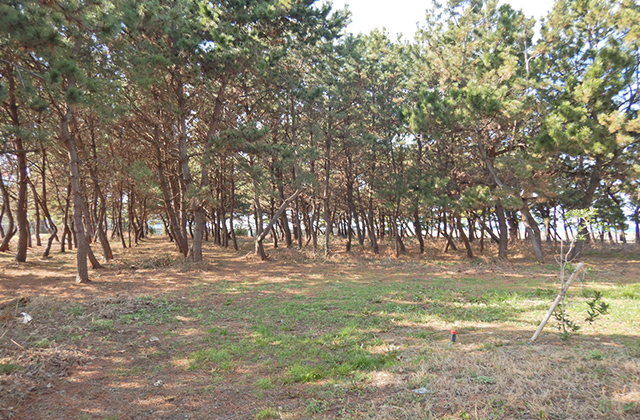Preserving biodiversity at business sites
Power Distribution Systems Center
Promoting Harmonious Coexisting in Nature at Our
Business Sites by Initiating Studies on Living Creatures
Maintaining a Bird-friendly Biotope
The Power Distribution Systems Center is located on reclaimed land facing the Seto Inland Sea in Kagawa Prefecture. The surrounding area has many rivers and parks, and birds from these rivers and parks make use of the wooded and grassy areas within our premises. We place great importance on coexisting with these birds and, based on expert advice, have created a waterside environment within our premises.
In January 2017, we installed a handmade biotope. After observing wild birds using our handmade biotope, we commissioned experts to construct a more advanced biotope in March 2018.
The experts incorporated waterside features into the biotope and planted aquatic vegetation. Additionally, fruit-bearing trees favored by wild birds were planted around the area. To facilitate rest and nesting for birds and insects, we incorporated nesting platforms, perches, and open water areas into the design. We also planted native vegetation around the area to promote harmony with the local environment.
In 2023, we invited experts to assess the current state of the biotope. Their findings highlighted that a sense of continuity between aquatic plants at the water’s edge and the surrounding mid- and low-growing shrubs helps birds feel more secure. They also identified the presence of Elodea nuttallii, an invasive species. We are actively working to address these issues through ongoing improvements.
-

Biotope created by experts
-

An eastern spot-billed duck using the biotope with its ducklings
Managing Black Pine Forest to Support Biodiversity

Black pine forest surrounding the biotope
We have been managing the black pine forest that stretches across the northwest area of our facility with a focus on biodiversity.
Based on advice received during the 2019 SEGES certification review and input from a research firm, we have removed dead trees that pose a risk of falling. We also regularly trim fast-growing plants such as kudzu. We leave some areas shaded by vegetation to provide habitats for insects and refuge for birds during bad weather and when typhoons approach.
The 2021 SEGES certification review acknowledged our management achievements, while also pointing out that the proportion of open, unobstructed areas was slightly too high. We will continue to improve our black pine forest management practices to better support biodiversity.